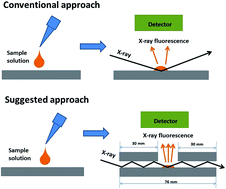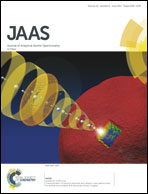Sample-in-waveguide geometry for TXRF sensitivity improvement†
Abstract
Total reflection X-ray fluorescence (TXRF) is a rapidly developing trace analysis method due to a number of advantages. It is a fast and multielemental method and does not require complex sample pretreatment. Nevertheless, there are certain drawbacks (especially in the environmental analysis) where TXRF sensitivity is not sufficient and employment of various preconcentration methods is required. The present study suggests a very simple procedure based on a planar waveguide technique, where the sample to be analyzed is placed directly into the waveguide. Waveguide construction is also simple and can be produced in any lab using two standard glass reflectors. Such an approach permits considerable improvement of the signal-to-noise ratio in a spectrum and allows for achievement of detection limits for e.g. Cd and Hg at 0.12 μg L−1 and 0.13 μg L−1 respectively.



 Please wait while we load your content...
Please wait while we load your content...